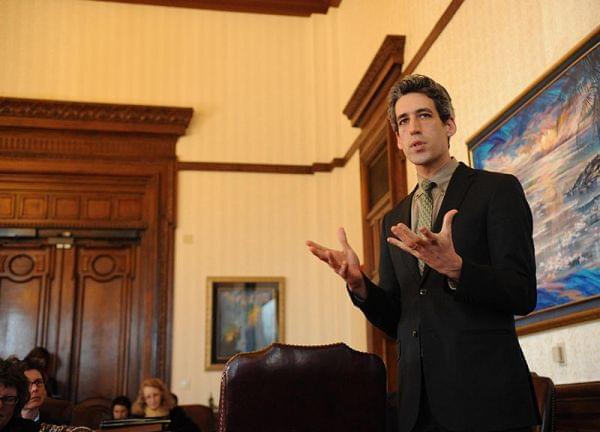Biss Brings Pensions Into Ed Funding Debate

State Senator Daniel Biss, a Democrat from Evanston. Office of state Sen. Daniel Biss
The last time the General Assembly tried to make school funding more equitable across Illinois, the legislation got derailed largely due to a fight over teacher pensions. Now pensions have cropped up again, this time in a bipartisan commission working to overhaul the school funding formula.
Since August, 20 lawmakers and scores of education advocates have been working to devise a fair method for divvying up state dollars for schools. Facing a deadline of February 1 to produce a new plan, they’ve hammered out a few areas of consensus. But on Tuesday, State Senator Daniel Biss, a Democrat from Evanston, challenged his colleagues to include teacher pensions in the discussion.
In a phone interview on Wednesday, Biss talked about how pensions are handled now, and why he hopes the Education Funding Reform Commission will consider a change.
“Under the current system in Illinois, the teachers who teach outside of the Chicago Public School system get their pension through something called the Teacher Retirement System. They put in 9.4 percent of each paycheck and then the state puts in the rest," Biss says. "In Chicago, teachers there put into something called the Chicago Teachers Pension Fund, and there, it’s the Chicago Public School district -- rather than the state -- that’s making most of the employer payment.”
Last spring, as part of a larger reform package, the Chicago teachers pension fund became the target of a partisan battle. Democrats proposed spending $200 million to cover teacher pensions at CPS. Republicans called it a Chicago bailout, killing the whole plan.
But under the current system, the state has little control over pension costs. There was a time when districts could give teachers big raises right before retirement to boost their pensions.
“Then laws were passed to limit those raises to 20 percent, and then much more recently, laws were passed limiting those raises to 6 percent,” Biss says.
That’s 6 percent for each of the last four years of an educator’s career -- teachers and administrators alike. So, for example, a principal making $140,000 per year can bump up to $180,000 for pension calculations. “It’s a pretty significant bump,” Biss says.
State Sen. Andy Manar (D-Bunker Hill) told the commission that -- depending on the district -- pension costs start at $300 per pupil and range upwards of four times that amount.
“Everyone understands that it makes more sense for the entity that’s actually setting the salary to be responsible for the payment,” Biss says. “There’s logic to that and I think it creates more transparency around any kind of negotiation that would happen between the district and the teachers, between the teachers and the state, or between the district and the state.”
The commission’s goal is overhauling the school funding formula -- a job that’s like untangling a dense, thorny hedge. Adding pensions to the mix is like hiding a snake in that hedge. When Biss brought it up Tuesday, the initial reaction was chilly. But Biss zeroed in on some pretty simple numbers.
“Illinois has a very property-tax-reliant school funding formula. We rely on property taxes more than any other state, and therefore we have a really inequitable system because obviously, districts with a lot of property wealth can spend a lot more on their schools than districts with very little property wealth. What our discussion is about is saying hey, as long as that’s true, at least we should make sure that the other money we spend on education creates some equity," Biss says. "That’s the formula we’re trying to improve.
“With that formula, we’re spending a little bit more than $5 billion a year. We’re also spending almost $4 billion on the Teachers Retirement System. In other words, we’re spending $5 billion to make things more equitable and $4 billion to make things less equitable.”
Number crunchers at the Illinois State Board of Education are now testing how pension costs might play with the other reforms under consideration. Will it stay in the plan? Biss doesn’t know.
“If we can’t reach consensus on that, I get it. I don’t want to derail our progress,” he says. “But if equity is the goal, and we’re going to try to improve equity on the $5 billion we’re spending in one way, and leave the inequity on the table with the $4 billion we’re spending the other way, that means we’ve still got a lot of work ahead of us.”
Links
- Illinois’ Pension Payment Expected To Increase By $400M
- Rauner Reports ‘Progress’ On Overhaul Of State Pensions
- Rauner Laughs At Cullerton Suggestion That Pensions, AFSCME Contracts Are Tied
- Illinois Issues: The Next Pension Time Bomb
- Pension ‘Deal’ Also Caught In Impasse
- Rauner Supports Democrat’s Pension Plan With Union Measure

